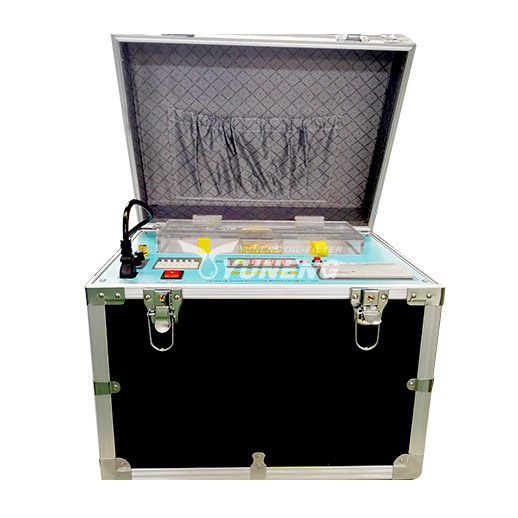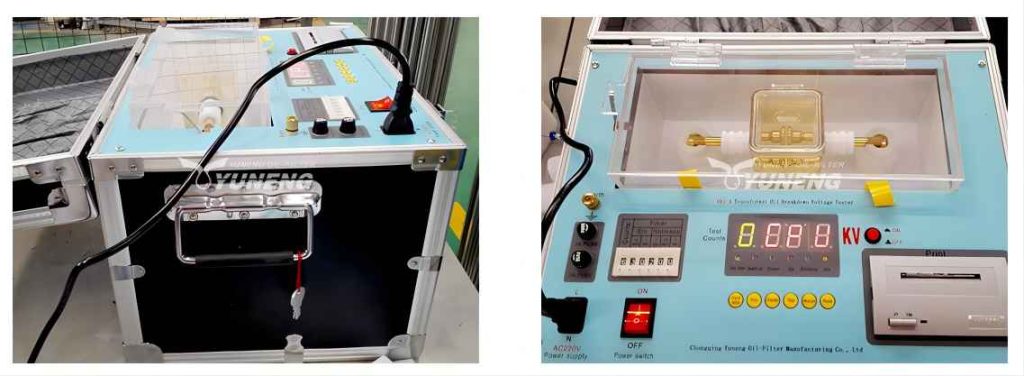How to Test Insulating Oil Breakdown Voltage by Oil BDV Tester?
Hidden within the intricate web of power grids, transformers operate quietly, adeptly converting voltage levels to effectively distribute electricity to households and industrial facilities. At the heart of these colossal machines lies a pivotal component: insulating oil. Serving as a crucial barrier, this oil shields the transformer’s internal mechanisms from electrical discharges, thus ensuring seamless functionality.
However, akin to any other component, the effectiveness of insulating oil diminishes over time due to numerous factors. Herein enters Breakdown Voltage (BDV) testing, serving as a pivotal diagnostic measure to evaluate the oil’s condition and avert potential transformer malfunctions.

Basics of Breakdown Voltage of Transformer Oil
What is the Breakdown Voltage of Transformer Oil?
To understand the “Breakdown Voltage” (BDV) of transformer oil, we first need to be introduced to dielectric strength. Dielectric strength is defined as the ability of the oil to withstand electrical stress without breaking down. Here, breaking down refers to the failure of insulating properties.
When oil is stored in drums, it gradually loses its dielectric strength, necessitating testing and treatment before its application in electrical equipment.
The breakdown voltage test for transformer oil holds paramount importance in ensuring the seamless operation of the transformer. Regular BDV testing of transformer oil guarantees its quality and integrity. This test involves assessing the voltage at which sparking occurs between two electrodes immersed in the oil, indicating a specific gap. A lower BDV value signifies the presence of moisture and conductive substances in the oil. According to the International Electrotechnical Commission (IEC), the minimum acceptable BDV value for transformer oil stands at 30 kV.
What Are the Main Factors Affecting the Breakdown Voltage of Transformer Oil?
- Moisture Content: The presence of moisture in the oil significantly reduces its BDV by forming conductive pathways.
- Contaminant Intrusion: Dust, dirt, and metal particles compromise oil purity and decrease its ability to resist breakdown.
- Aging and Oxidation: Over time, inherent aging and oxidation processes naturally weaken the oil’s insulating strength.
- Dissolved Gas Analysis: During aging and stress, the oil releases signature gases like hydrogen and carbon dioxide. Combining BDV testing with dissolved gas analysis provides valuable insights into potential transformer faults for early detection and corrective action.
- Operational Stress and Thermal Management: High operating temperatures, overloading, and arcing events accelerate oil degradation and negatively impact BDV.

Why Should a BDV Test Be Performed on the Insulating Oil of The Transformer?
Regular breakdown voltage (BDV) testing of the insulating oil in transformers acts as a crucial diagnostic tool, providing insights into the oil’s health and insulating ability, ultimately safeguarding the transformer from potentially catastrophic failures. Here’s a breakdown of why BDV testing is essential:
Ensuring Safety
- Early Detection of Deterioration: Transformer oil naturally degrades over time due to factors like moisture, contamination, and oxidation. BDV testing detects these changes before they compromise the oil’s insulating properties, preventing potential breakdowns and arcing faults, which can damage the transformer and pose safety risks to personnel and equipment.
- Proactive Maintenance: By identifying changes in BDV early, maintenance teams can implement timely corrective actions like filtration or oil replacement, preventing further deterioration and costly repairs.
- Regulatory Compliance: Many regions have regulations mandating periodic BDV testing of transformer oil. Complying with these regulations not only ensures safety but also avoids potential legal ramifications.
Optimizing Performance
- Maximized Lifespan: Regular BDV testing helps ensure the oil functions optimally, extending the transformer’s lifespan and saving on replacement costs.
- Improved Reliability: Timely oil maintenance based on BDV results minimizes the risk of unexpected outages, ensuring a more reliable and stable power supply.
- Cost-Effectiveness: Early detection and correction of oil issues through BDV testing prevents more significant and expensive problems down the line, making it a cost-effective maintenance practice.
Additionally, BDV testing is a relatively simple and non-invasive procedure, ensuring minimal downtime for transformer operations. It is user-friendly and portable, allowing for on-site testing, further enhancing convenience.
The Principle of Insulating Oil BDV Test
The principle behind insulating oil Breakdown Voltage (BDV) testing involves placing a sample of the insulating oil into an oil cup, followed by the addition of a controlled rate of voltage increase. The voltage is steadily raised until either the insulating oil breaks down or the applied voltage reaches the maximum test voltage value. This process yields the dielectric strength of the insulating oil, crucial for assessing its suitability for use in transformers and other electrical equipment.
However, achieving accurate results in BDV testing is influenced by various factors, including the distribution of impurities within the insulating oil. Impurities can disperse unevenly due to factors such as Brownian motion, which describes the random movement of particles suspended in a fluid. As a result, the test results for breakdown voltage may exhibit dispersion, necessitating multiple tests to obtain reliable data.
Given the stringent conditions required for oil breakdown voltage testing, specialized equipment known as breakdown voltage testers are employed. These testers are designed to meet the precise requirements of the testing process, ensuring accurate and repeatable results. By conducting BDV testing under controlled conditions, manufacturers and operators can assess the quality and performance of insulating oils with confidence, thereby maintaining the integrity and reliability of electrical systems.
YUNENG Transformer Oil BDV Tester

The YNHYG-A Series IEC Standard Transformer Oil BDV Tester explored by YUNENG emerges as a self-contained solution for assessing the health of insulating oil in transformers. Built to comply with international (IEC-156) and national (GB507-86) standards, it leverages microprocessor control for automated testing, minimizing errors and simplifying operation. This user-friendly design, coupled with its portability, makes it ideal for both field and lab environments.
The YNHYG-A Series IEC Standard Transformer Oil BDV Tester boasts several notable features:
- The device offers automated detection capabilities, streamlining the testing process.
- Equipped with a compact TPU-A panel printer, the tester facilitates the automatic printing of test results, ensuring efficient documentation.
- Users can customize testing parameters such as testing times, stirring duration, and stationary time, enhancing flexibility and accuracy. Sound and light controls provide alerts for continuous printing and non-printing phases.
- Incorporating full automatic magnon technology, the tester ensures reliable and precise testing outcomes, contributing to enhanced efficiency and performance.
Whether you’re a seasoned professional or seeking a reliable BDV testing solution, exploring the YNHYG-A Series in greater detail is recommended.

